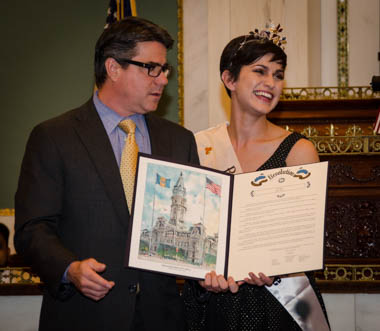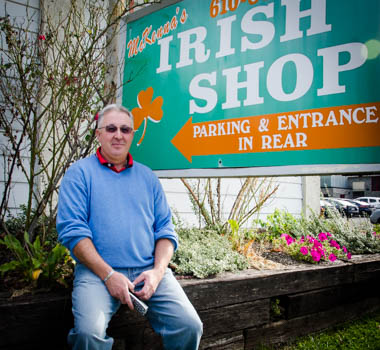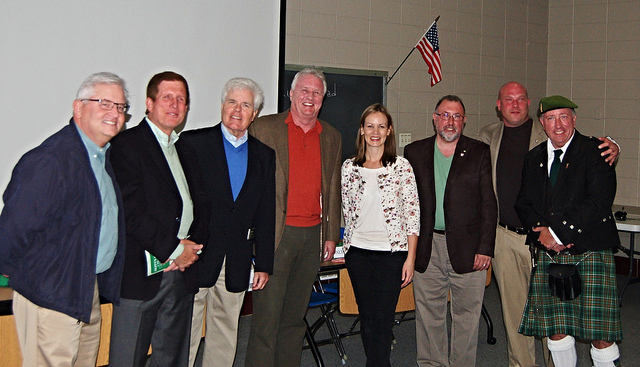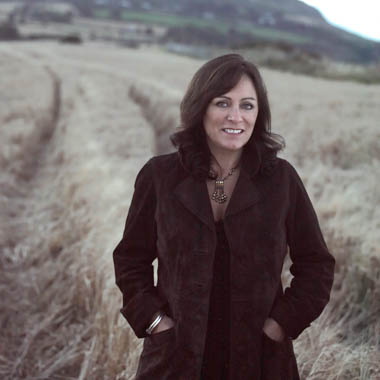
Janet Brennan, Max Resnick, and therapy horse, Windy.
Janet Brennan had never been around horses, couldn’t ride and, she admits sheepishly, “didn’t even know how to handle them,” when the Furlong woman bought her first animal, a quarter horse mare she named Irish, in 1998.
It didn’t make a lot of sense—she traveled the world all but four days of every month as a clinical research nurse in the pharmaceutical industry. But Irish fulfilled a long-buried yearning she’d had since she was a child. “I’ve always loved and been drawn to horses,” she says.
It wasn’t long after that another longing emerged—one that totally mystified her. “I kept thinking I wanted to get involved in equine therapy and I wasn’t really sure what it was,” says Brennan, who also spent six years as an ER nurse.
Equine therapy, often called equine-assisted therapy, is an unusual but well-studied treatment that uses horses to help treat a variety of conditions, from helping autistic children learn to connect to improving muscle tone in people with cerebral palsy.
“I feel it’s a calling, that I was being pulled in this direction,” said Brennan who last month, opened Shamrock Reins, an equine therapy center for military vets, first responders, and their families, on 22 acres in Pipersville, Bucks County. (“Shamrock” stands for “Special Horses Assisting with Miracles and Recovery Offering Comfort and Kindness,” but it also reflects Brennan’s Irish roots, also evident in the horses’ names: Irish, Dublin, Clancy Donegal, Paddy, Emerald. . . .)
And she had confirmation that she was being led by unseen forces to her second career the day the certified therapeutic riding instructor she’d hired called at the last minute and told her she wasn’t going to take the job. “I had 15 minutes of pure panic. Then, in the middle of that,” she says, “the phone rang.”
It was a man named Max Resnick, a 23-year Navy veteran, who heard through the director of another equine therapy program that Brennan was looking for someone. Like Brennan, Resnick loved horses from the time he was young. Growing up in New York City, he was glued to the family’s tiny black-and-white TV every morning incongruously watching the farm reports while other kids his age were being hypnotized by Tom & Jerry cartoons.
“I got my first opportunity to ride right before I became a teenager,’ says Resnick, and he continued to ride even after joining the Navy. “They don’t allow horses on a ship,” he jokes, so he begged and borrowed rides in every port of call, from Scotland to Guam. Once he retired, he got his certification from PATH, the Professional Association of Horsemanship, International, one of the largest organizations of its kind in the world. He was determined to make his second career one that involved the horses he’d loved all his life.
“I am 100 percent certain that God sent him to me,” says Brennan, a trim, red-haired woman with the calm easy manner of someone used to being around both patients and horses. “There’s no one better than a veteran to understand the problems of other veterans.”
The daughter of a Vietnam veteran, Brennan was drawn to the plight of today’s combat veterans, nearly 300,000 of whom have suffered a traumatic brain injury and a quarter of whom have “invisible wounds,” often debilitating psychological problems such as post-traumatic stress disorder. “There’s estimated to be as many as 24 suicides a day among combat vets,” she says.
Horses are uniquely suited as therapy animals for people with emotional issues. They’re the original empathetic listeners. “Horse are a mirror of your mind and your behavior,” says Brennan. “They sense your energy, your emotional state. If you’re anxious, they’ll be anxious. If you’re relaxed, they’ll relax.”
They are, in fact, like all prey animals, says Resnick. “Their survival depends on their ability to be alert to whatever might be a danger to them.”
For a combat vet who might be keeping sharp-edged feelings sheathed, hidden even from himself, “the horse becomes the therapist,” Resnick says, reflecting back what it senses from the hand that grooms her or the rider on her back. “When the vets start talking about the horse, it doesn’t take them long to realize they’re talking about themselves,” he says.
There are other benefits to working with horses. For one thing, they’re forgiving—and forgetful—if they’re treated with affection and kindness. “You do something that’s not what you should be doing and you have three seconds to tell them it’s okay, you didn’t mean it, and they forget it. Three seconds. They teach us how to live in the moment,” Resnick says with a smile.
There’s also a sense of mastery in being able to control and animal that outweighs you by at least 900 pounds, sometimes more. Horses can be scary, even if you’ve been trained for war. “My son who is six-feet tall, 250 pounds, and is a hand-to-hand combat instructor went with his wife to a stable near Fort Benning,” says Resnick, grinning as he tells the story. “He was in the paddock when one of the horses snorted. Mr. Able-To-Leap-Tall-Buildings was suddenly outside the paddock, not even sure how he got there. He told the woman at the barn, ‘That horse hates me.’ She said, ‘The horse just sneezed.’ They’re big animals, and if you don’t know anything they can be frightening.” He laughed.
As an RN who worked in clinical research, Brennan was interested in the scientific evidence behind equine-assisted therapy, particularly for combat vets with PTSD and traumatic brain injury. It wasn’t hard to find. In fact, a study reported in a recent issue of The Journal of Rehabilitation Research and Development found that vets who started out deeply depressed and isolated—some hadn’t left their homes in a year or more–became more sociable as the result of working with horses and human equine therapists. Most of the vets told researchers they found the horse to be “intuitive,” “a good listener,” and “compassionate.” Many said that working with the horses helped them build trust with the humans in their lives. “I talk to people, I shake people’s hands,” one vet said. “When you’re with a horse, they give you kindness and compassion and love and they don’t expect anything,” another participant wrote.
Brennan, who with Resnick is now in the process of making the connections to bring vets and first responders and their families to the program, has talked to combat veterans herself, many of whom have been through similar programs. “Every single one says the same thing—once you get one, more will come. When they leave, they tell everyone they know. One of them told me, ‘you’d better have a lot of programs, because once we come, we won’t stop coming.’
“Our mission,” she says, “is to create life-changing experiences for people who’ve had their lives changed not in positive ways. If I can save someone from committing suicide, I’ve done what I’ve had to do.”
You can become involved in Shamrock Reins in many ways—as a participant (all of the programs are free); as a volunteer; and as a donor. The organization is a 501 (c)(3) charity, so all donations are tax deductible. Go to their website for more information.
On Sunday, Blackthorn is performing at a fundraiser for the organization at Spring Hill Manor in Ivyland.
[flickr_set id=”72157649165706975″]








